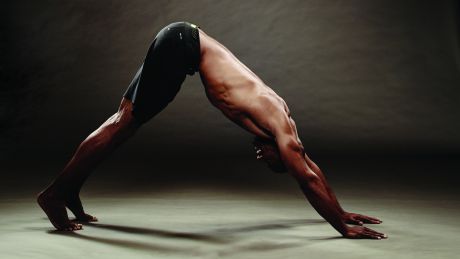How To Do Downward-Facing Dog
Runners, weightlifters and just about everyone else will benefit from doing this yoga pose

Even those who have never spent a single minute in a yoga studio will have heard of downward-facing dog, or adho mukha śvānāsana for those familiar with Sanskrit (hello to you). It’s just about the most well-known yoga pose, but that knowledge doesn’t extend beyond a basic familiarity for most of us, so we enlisted Joey Miles, an ambassador for yoga brand so we flow… and teacher at Ashtanga Yoga Leeds, for more info on the benefits of the downward-facing dog and how to do it.
“In downward-facing dog pose you imitate a dog stretching,” says Miles. “Watch any dog just after it gets out of its basket and you’ll see what I mean. It’s a beneficial pose because it involves the whole body. You learn to bear weight through your arms and shoulder girdle while simultaneously lengthening the spine, and stretching and strengthening the legs. Over time, if done well, it is also calming for the mind.
“Runners find it quickly reduces stiffness in the hamstrings and calf muscles, while those who lift weights find it releases tension in the shoulders and back. But the greatest overall benefit is the freedom it brings to the respiratory diaphragm – put simply, when you breathe deeper you have more energy and feel calmer.”
How To Do Downward-Facing Dog
There is more than one way to skin a cat and that goes for performing downward-facing dog too. Below you’ll find three methods from Miles to try – stick with what works for you.
Method 1
This first method teaches the “standard” distance between the hands and feet.
Start in a top press-up position with your hands shoulder-width apart (if you have tight shoulders go wider) and feet hip-width apart. Your body should form a straight line from the crown of your head to your heels. Engage your core so your body does not dip in the middle.
Without moving your hands or feet, lift your pelvis as high as possible. Press your heels back, and raise your legs without taking your feet off the floor. Push through your arms, spread your fingers and press your palms down. Engage your quadriceps so your kneecaps rise.
Sign up for workout ideas, training advice, reviews of the latest gear and more.
Breathe slowly and deeply through your nostrils, and let your abdomen relax. Relax your face and release the hinges of your jaw. Focus on what proportion of your bodyweight is in your arms and your legs. If you are new to the move, aim for 50/50.
Method 2
This method will stretch your calves more and take some pressure out of your shoulders.
Start in the top press-up position as in method 1. Lift your pelvis as high as you can, and notice how the tension in your abdomen releases spontaneously. This time, step your feet forwards toward the hands, approximately 15cm. Your feet should be parallel with your toes pointing straight forwards.
As in method 1, engage your quads and press your thighs back and upwards while simultaneously pressing your heels down.
Keep your thumbs and index fingers grounded as you turn the upper arms out to broaden across your shoulder girdle.
Relax your neck and check your ears are in line with your upper arms. As you breathe in deeply, feel the sides of your ribcage becoming wider. Then as you exhale fully, feel your abdomen release.
See related
- Four Unexpected Benefits Of Yoga
- “Guys Who Do Weights Or Run – Yoga Changes Their Lives”
- Yoga For Runners: Five Moves To Help You Recover After Long Runs
Method 3
Once you know the shape and feeling of the poses above, try this variation.
Place your hands on a table, ideally about the same height as your hips, or alternatively press your hands against a wall at hip height. Bend at your waist and stand with your feet directly under your hips, so your arms and spine form one long line that’s perpendicular to the floor.
Press your thighs back and push forwards through your arms. Now that you have less weight in the shoulders, see if you can create even more length in your waist.

Nick Harris-Fry is a journalist who has been covering health and fitness since 2015. Nick is an avid runner, covering 70-110km a week, which gives him ample opportunity to test a wide range of running shoes and running gear. He is also the chief tester for fitness trackers and running watches, treadmills and exercise bikes, and workout headphones.
